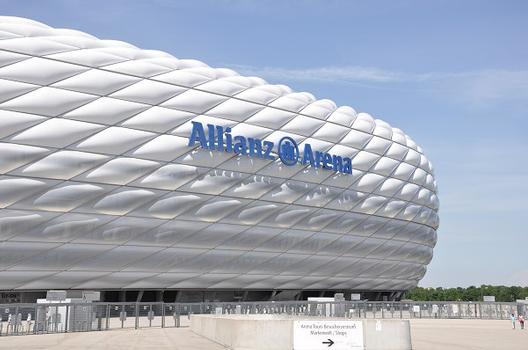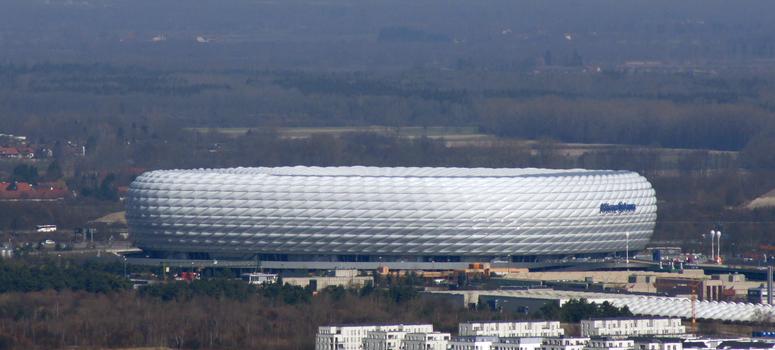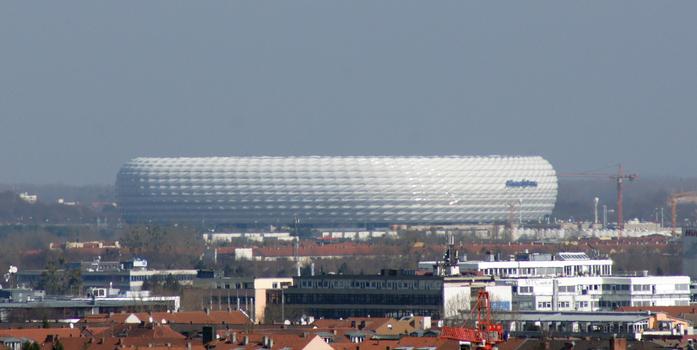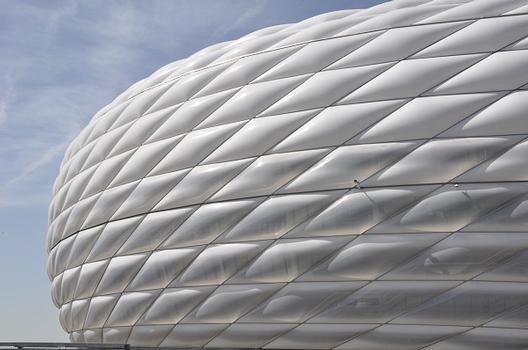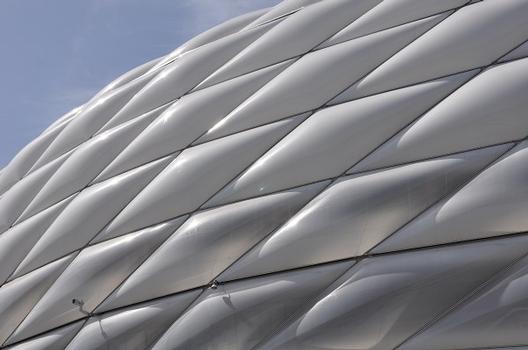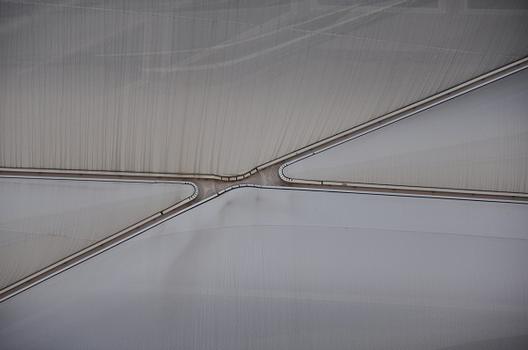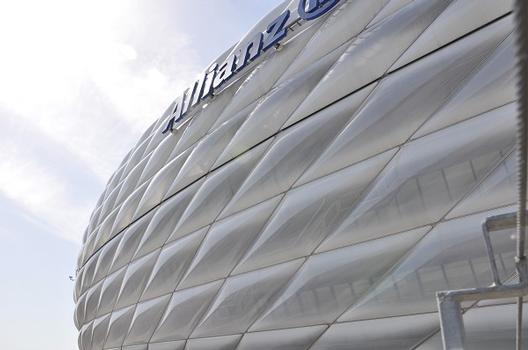General Information
Project Type
| Function / usage: |
Stadium / Arena |
|---|---|
| Structure: |
Truss-supported membrane structure |
| Architectural style: |
Blobitecture |
| Material: |
roof: Steel structure grand stands: Reinforced concrete structure |
Location
| Location: |
Fröttmaning, Schwabing-Freimann, Munich, Bavaria, Germany |
|---|---|
| Part of: | |
| Coordinates: | 48° 13' 8" N 11° 37' 29" E |
Technical Information
Dimensions
| height | 52.00 m | |
| seats | 75 021 | |
| building area | 37 600 m² | |
| exterior length | 234 m | |
| exterior width | 202 m | |
| gross floor area | 171 000 m² | |
| interior height | 53.00 m | |
| membrane | membrane covered area | 64 000 m² |
| playing field | width | 68 m |
| length | 105 m | |
| roof truss | length | 71.0 m |
| cantilever length | 58.5 m |
Quantities
| structural steel | 20 000 | |
| concrete volume | 107 000 m³ |
Cost
| cost of construction | Euro 275 000 000 |
Materials
| truss |
steel
|
|---|---|
| grand stands |
reinforced concrete
|
| façade cushions |
ETFE foil
|
Chronology
| 21 October 2002 | The first stone is laid in a ceremony marking the beginning of construction. |
|---|
Excerpt from Wikipedia
Allianz Arena [ʔaˈli̯ants ʔaˌʁeːnaː] is a football stadium in Munich, Bavaria, Germany with a 75,000 seating capacity. Widely known for its exterior of inflated ETFE plastic panels, it is the first stadium in the world with a full colour changing exterior. Located at 25 Werner-Heisenberg-Allee at the northern edge of Munich's Schwabing-Freimann borough on the Fröttmaning Heath, it is the second-largest arena in Germany behind Westfalenstadion in Dortmund.
FC Bayern Munich has played its home games at the Allianz Arena since the start of the 2005–06 season. The club had previously played their home games at the Munich Olympic Stadium since 1972. 1860 Munich previously had a 50% share in the stadium, but Bayern Munich purchased their shares for €11 million in April 2006. The arrangement allowed 1860 Munich to play at the stadium while retaining no ownership until 2025. However, in July 2017 the rental contract was terminated, making Bayern Munich the sole tenants of the stadium.
The large financial services provider Allianz purchased the naming rights to the stadium for 30 years. However, this name cannot be used when hosting FIFA and UEFA events, since these governing bodies have policies forbidding corporate sponsorship from companies that are not official tournament partners. During the 2006 FIFA World Cup, the stadium was referred to as FIFA WM-Stadion München (FIFA World Cup Stadium, Munich). In UEFA club and Nations League matches, it is known as Fußball Arena München (Football Arena Munich) [ˌfuːsbal ʔaʁeːnaː ˈmʏnçn̩], and it hosted the 2012 UEFA Champions League Final. The stadium has been nicknamed "Schlauchboot" ("dinghy"). Since 2012 the museum of Bayern Munich, FC Bayern Erlebniswelt, has been located inside the Allianz Arena.
Allianz Arena is lit in red when the host team is Bayern Munich, was lit in blue when it hosted 1860 Munich, and is lit in white when the German national team hosts the match. Part of Allianz Arena roof's sun-shade blinds rolled open Illumination during the UEFA Champions League final 2011–12 Allianz Arena with the Holy Cross Church, the oldest church of Munich.
Design
Capacity
Effective with the city's approval of modifications that was granted 16 January 2006, the legal capacity of the stadium increased from 69,000 to 71,000 spectators (including standing room). The lower tier can seat up to 20,000, the middle tier up to 24,000, and the upper tier up to 22,000. 10,400 of the seats in the lower tier corners can be converted to standing room to allow an additional 3,120 spectators. The total capacity includes 2,000 business seats, 400 seats for the press, 106 luxury boxes with seating for up to 174, and 165 berths for wheelchairs and the like. From the second half of the 2005–06 Bundesliga season, the arena is able to accommodate 69,901 spectators at league and DFB-Pokal games, but because of UEFA regulations, the capacity remained at 66,000 seats for UEFA Champions League and UEFA Cup games. Bayern Munich limited capacity during their league and cup games to 69,000. The partial roof covers all seats, although winds can still blow rain onto some of them. Prior to the 2012–13 season, Bayern Munich announced that capacity had been increased to 71,000 for domestic matches and 68,000 for UEFA matches, with the addition of 2,000 seats in the upper tier of the arena.
Allianz Arena also offers three day-care centers and a fan shop, the FC Bayern Munich Megastore. Merchandise is offered at stands all along the inside of the exterior wall inside the area behind the seats. Numerous restaurants and fast-food establishments are also located around the stadium.
There are four team locker rooms (one each for the two home teams and their respective opponents), four coaches' locker rooms, and two locker rooms for referees. Two areas are provided where athletes can warm up (approx. 110 m² each). There are also 550 toilets and 190 monitors in the arena.
On 28 April 2013, FC Bayern announced to sell 300 more tickets in the Südkurve starting with the 2013–14 Bundesliga season.
On 21 January 2014, Karl-Heinz Rummenigge declared that FC Bayern discusses a further expansion of the Allianz Arena. About 2,000 new seats to be installed in the upper tier and about 2,000 more tickets are to be sold in the Nord- and Südkurve. In August 2014, it was reported that the capacity expansion was completed leading to a new maximum capacity of 75,024 in the Bundesliga and 69,334 in international matches. An expansion was approved in January 2015 to expand the stadium's capacity to 75,000 for Bundesliga Games and 70,000 for games in the Champions League.
Construction
The stadium construction began on 21 October 2002 and was officially opened on 30 May 2005. The primary designers are architects Herzog & de Meuron. The stadium is designed so that the main entrance to the stadium would be from an elevated esplanade separated from the parking space consisting of Europe's biggest underground car park. The roof of the stadium has built-in roller blinds which may be drawn back and forth during games to provide protection from the sun.
- Total concrete used during stadium construction: 120,000 m³
- Total concrete used for the parking garage: 85,000 m³
- Total steel used during stadium construction: 22,000 tonnes
- Total steel used for the parking garage: 14,000 tonnes
Luminous exterior
The arena facade is constructed of 2,874 ETFE-foil air panels that are kept inflated with dry air to a differential pressure of 3.5 Pa. The panels appear white from far away but when examined closely, there are little dots on the panels. When viewed from far away, the eye combines the dots and sees white. When viewed close up however, it is possible to see through the foil. The foil has a thickness of 0.2 mm. Each panel can be independently lit with white, red, or blue light. The panels are lit for each game with the colours of the respective home team—red for Bayern Munich, blue for TSV and white for the German national football team. White is also used when the stadium is a neutral venue, like the 2012 UEFA Champions League Final. Other colours or multicolour or interchanging lighting schemes are theoretically possible, but the Munich Police strongly insists on using a single-colour lighting scheme due to several car accidents on the nearby A9 Autobahn with drivers being distracted by the changing lights.
Allianz Arena's innovative stadium-facade lighting concept has been subsequently adopted in other newly built venues, like MetLife Stadium in New Jersey, which lights up in blue for the National Football League's Giants and green for the Jets. With electricity costs for the light of about €50 (USD$75) per hour, the construction evolved such luminosity that in clear nights the stadium can easily be spotted even from Austrian mountain tops, e.g. from a distance of 50 miles (80 km).
Transport
Patrons may park their cars in Europe's largest parking structure, comprising four four-story parking garages with 9,800 parking places. In addition, 1,200 places were built into the first two tiers of the arena, 350 places are available for buses (240 at the north end, and 110 at the south entrance), and 130 more spots are reserved for those with disabilities.
The stadium is located next to the Fröttmaning U-Bahn station. This is on the U6 line of the Munich U-Bahn.
Surroundings
From the subway station just south of the arena, visitors approach the stadium through a park that was designed to disentangle and guide them to the entrance. An esplanade rises gradually from ground level at the subway station entrance, practically building the parking garage's cover, to the entrance level of the stadium. On the other side of the Autobahn, the Fröttmaning Hill with its windmill affords a marvellous view on the stadium. Also the Romanesque Heilig-Kreuz-Kirche, the oldest structure on the area of the City of Munich designed to serve religious purposes, is located there together with its copy, an artwork in concrete as a reminder for the village of Fröttmaning which disappeared with the construction of the Autobahn.
Owners
The arena was commissioned by the Allianz Arena München Stadion GmbH, founded in 2001, and was owned in equal parts by the two football clubs that call it home. The GmbH's CEO was Karl-Heinz Wildmoser, Jr. until the unraveling of the stadium corruption affair (see below). Since then, Bernd Rauch, Peter Kerspe, and Walter Leidecker have led the company. In April 2006, FC Bayern Munich bought out TSV 1860 Munich's 50% share in the arena for a reported €11 million. 1860 managing director Stefan Ziffzer stated that the deal prevented insolvency for the club. The terms of the agreement gave 1860 the right to buy back their 50% share of the arena for the price of sale plus interest anytime before June 2010. In November 2007, 1860 Munich resigned that right. In advance, the income of two friendly-games both clubs shared equally instead of having that money going to Allianz Arena GmbH. Due to financial turbulences of 1860 Munich, Bayern Munich took over all the shares and now owns 100% of the Allianz Arena.
Name
Allianz paid significant sums for the right to lend its name to the stadium for a duration of 30 years. However, as Allianz was not a sponsor of the 2006 World Cup and is not an official UEFA sponsor, the Allianz logo had to be removed during the World Cup and is covered during Champions League games.
Cost
The cost of the construction itself ran to €286 million but financing costs raised that figure to a total of €340 million. In addition, the city and State incurred approximately €210 million for area development and infrastructure improvements.
Reactions
On 14 November 2005 at the annual general meeting, many FC Bayern Munich club members complained about the uncomfortable draft inside the arena. As a result, closable doors were installed and spectators now enjoy watching the games in greater comfort.
The Ultras and many other fans protested at several home games against the seats and some of the rules of the arena which they perceive as "fan unfriendly". For example, a spectator may not enter with a megaphone or a pennant that a single person cannot carry unfurled, and pennant poles with a length of over one metre are prohibited. The complaint is that these rules and the designer seats put a damper on the fan experience. The presence of a large fence and safety nets in front of the southern curve (seat bloc reserved for fans of FC Bayern Munich) are also often criticized.
These complaints have had some success. From the 2006–07 season, blocks 112 and 113 have been converted into terracing, in the usual German style so that seats can be installed for UEFA and international matches, whose regulations demand seating for all spectators.
History
On 21 October 2002, voters went to the polls to determine whether a new stadium should be built in this location and whether the city of Munich should provide the necessary infrastructure. About two thirds of the voters decided in favor of the proposition. An alternative to constructing the new arena had been a major reconstruction of the Olympic Stadium but this option had been refused by its architect Günther Behnisch.
The Swiss architect firm of Herzog & de Meuron then developed the concept of the stadium with a see-through exterior made of ETFE-foil panels, that can be lit from the inside and are self-cleaning. Construction started in the autumn of 2002 and was completed by the end of April 2005.
The Fröttmaning and Marienplatz stations of the subway line U6 were expanded and improved in conjunction with the arena construction. The Fröttmaning subway station was expanded from two to four tracks, while the Marienplatz U-Bahn station was outfitted with additional pedestrian connector tunnels running parallel to the subway tracks, which lead towards the S-Bahn portion of the station, lessening congestion among passengers making connections to the Munich S-Bahn. To be able to handle the additional traffic load, the Autobahn A9 was expanded to three and four lanes going each way and another exit was added to the A99 north of the arena.
On 19 May 2012, the 2011–12 UEFA Champions League final was held at the Allianz Arena. Bayern Munich, who were drawn as home team, was set to play against Chelsea. Chelsea won on penalties after the game had tied 1–1 after regulation and extra time. Bastian Schweinsteiger's penalty hit Petr Čech's left post, and Didier Drogba scored the winning penalty.
On 25 May 2012, Bayern opened a museum about its history, FC Bayern Erlebniswelt, inside the Allianz Arena.
Stadium corruption affair
Between March 2004 and August 2006, a corruption affair relating to the stadium occupied the football world and German courts. On 9 March, Karl-Heinz Wildmoser, Sr., president of TSV 1860 Munich, his son Karl-Heinz Wildmoser, Jr., chief executive officer of Allianz Arena München Stadion GmbH, and two others were charged with corruption in connection with the award of arena construction contracts and taken into custody. On 12 March 2004, Wildmoser, Sr. struck a plea bargain and was released. As part of the plea bargain, he relinquished the presidency of the club three days later, and on 18 May, the investigation into his conduct was closed.
His son, Karl-Heinz Wildmoser, Jr., remained in custody. At a bail hearing on 29 June, the judge refused bail on the grounds of danger of flight and obstruction of justice. The District Attorney filed charges on 23 August 2004, accusing him of fraud, corruption and tax evasion. The case was that Wildmoser, Jr. had awarded the construction contract at an inflated price, provided the Austrian builder Alpine with inside information that enabled the builder to win the contract, and in return received €2.8 million.
On 13 May 2005, Karl-Heinz Wildmoser, Jr. was convicted and sentenced by a Munich court to four and a half years in prison. He was released on bail pending his appeal. The Federal Court of Justice rejected the appeal in August 2006.
Opening day
On 30 May 2005, 1860 Munich played an exhibition game against 1. FC Nürnberg. The next day, the record German champions Bayern Munich played a game against the Germany national team. Both games had been sold out since early March 2005. Patrick Milchraum of TSV 1860 scored the first official goal at the stadium.
On 2 June, in response to high demand, the first "arena derby" took place between the two tenants. That game was won by TSV 1860 with the help of a goal by Paul Agostino.
Prior to opening day the alumni teams of both clubs played each other in an exhibition game in front of a crowd of 30,000 where all stadium functions were thoroughly tested.
The stadium's first goal in a competitive game went to Roy Makaay of FC Bayern in the semi-finals of 2005 DFL-Ligapokal on 26 July 2005. In the same game, Thomas Hitzlsperger of VfB Stuttgart scored the first goal in an official game by a visiting team. The game ended with a 2–1 win for Stuttgart.
The first goal in a league game was scored by Owen Hargreaves of FC Bayern when the home team won 3–0 in its 2005–06 Bundesliga season opener against Borussia Mönchengladbach on 5 August 2005. The first goal in a league game by a visiting team was scored by Dynamo Dresden on 9 September 2005 in the 2. Bundesliga match against 1860 Munich. That game ended in a score of 1–2 in front of a full house which included approximately 20,000 – 22,000 fans who had traveled to Munich from Dresden for the game. Dresden thus became the first visiting team to win a league game at Allianz Arena.
The first goal against FC Bayern Munich in a league game at Allianz Arena was scored by Miroslav Klose of Werder Bremen on 5 November 2005 in the first minute of play. This was to remain the visitors' only goal that day as the game went to the FC Bayern with a final score of 3–1.
FC Bayern broke its consecutive sell-out record by selling out each of its first ten home games at Allianz Arena.
Text imported from Wikipedia article "Allianz Arena" and modified on July 22, 2019 according to the CC-BY-SA 4.0 International license.
Participants
-
Herzog & De Meuron Architekten
- Pierre de Meuron (architect)
- Jacques Herzog (architect)
- Arup Deutschland GmbH (Stadium)
- IB Haringer (circular gallery)
- Ingenieurplanung Leichtbau GmbH (façade)
- Kling Consult (Esplanade)
- Sailer Stepan und Partner GmbH (roof)
- Walther Mory Maier Bauingenieure AG (Esplanade)
- Anker Schroeder ASDO GmbH
- Membranteam GmbH (membrane)
- Rope Access Solutions
- Stottrop-Textil GmbH & Co. KG

Relevant Web Sites
Relevant Publications
- (2006): The Allianz Arena. A new football stadium for Munich, Germany. In: The Arup Journal, v. 41, n. 1 ( 2006), pp. 24-31.
- (2005): Allianz Arena - Das neue Münchner Fußballstadion. In: Stahlbau, v. 74 ( 2005), pp. 168-178.
- Allianz Arena für vorbildlichen Brandschutz ausgezeichnet. In: Bauphysik, v. 28, n. 3 (June 2006), pp. 191.
- (2004): Die Allianz Arena, Neubau eines Fußballstadions in München. Wettbewerb und Tragwerksplanung der "Stadionschüssel". In: Bauingenieur, v. 79, n. 5 (May 2004).
- (2005): Allianz Arena: Brandschutzkonzept für ein Fußballstadion - mit Brandversuchen zum Erfolg. In: Bauphysik, v. 27, n. 1 (February 2005), pp. 9-14.
- About this
data sheet - Structure-ID
20002923 - Published on:
09/02/2002 - Last updated on:
20/06/2016

